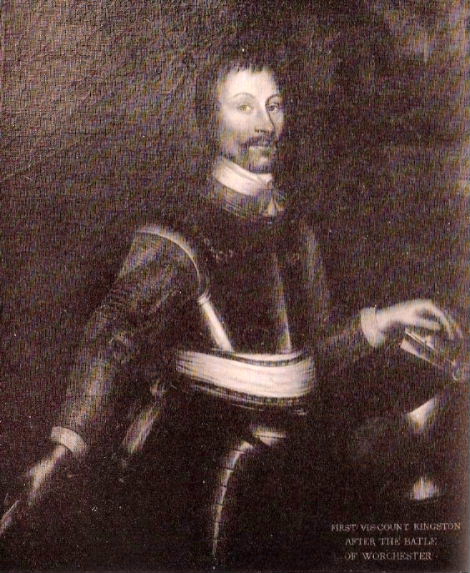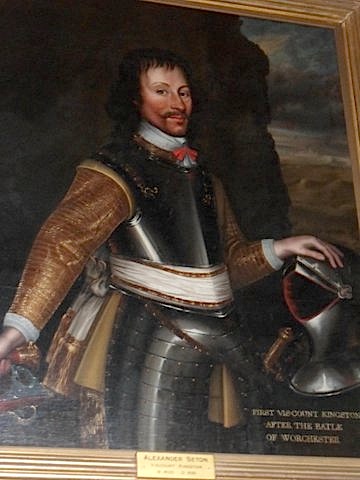|

Sir Alexander Seton, 1st Viscount of Kingston, Baron
Stoneypath and Whittingehame
Sir Alexander
Seton was the second son of George, 3rd Earl of Winton by
his 1st wife Anne Hay. Born 13 March 1620, he was knighted early in
life at the age of twelve by the King on a state visit to the
family home at Seton Palace, noted in Seton chronicles as
follows:
This Sir
Alexander Seton, in anno 1633 when King Charles I came to
Seton, being then not 12 years of age, he welcomed the King
with a Latin oration at the iron gate of Seton; where his
Majesty sat in state, all the English nobility sitting round
about him. The said Sir Alexander being attended with his
schoolmaster, with a pedagogue, and other four Mailers of
Art ; all grave learned men, cled in fine black cloth, and
cloaks lined through with pan velvet ; the ground being
covered a great way from the throne with carpet :
Where,
after due reverence thrice made to his Majesty by the said
Sir Alexander and his mailers, the said Sir Alexander did
deliver his oration boldly, with a gesture suitable to the
purpose, for which he had the applause of his Majesty, and
all present; and, before he rose from his knees, his Majesty
did him the honour to knight him, and said to him, " Now,
Sir Alexander, see this does not spoil your school; by
appearance, you will be a scholar." The said Sir Alexander
boldly answered, " No, please your Majesty, it shall not."
He was well educated
and continued his studies on the Continent, traveling
extensively throughout France, Spain and Rome and returning
home to Scotland in 1640. He was not long to rest,
when the religious troubles of the day forced him to flee to
Flanders (Holland); returning 8 months later, only to find the
persecution increasing. He refused to sign The
Covenant, for which he and his family members were
excommunicated "by the mouth of Mr. Ballanquail" at Tranent
Church, and they were forced to flee again, this time to
France.
Nevertheless, upon return yet again he pursued a military career
and with his father he was highly active in the support of the Stuart
Monarchy's of both King's Charles I and II. He became a
primary dispatch in the service of the King personally, and
of the Royal Court in exile, having continually carried
State business and represented His Majesty, for which he was
created a Cavalier; the first dignity Charles II conferred
as King, "having not yet made a Knight", and created
him Viscount of Kingston, which parish was part of his own
paternal estate's in Dirleton near North Berwick.
As a Captain of the Royalist
forces, he was the Commander of Tantallon Castle, and was responsible
for the famous raids against Cromwell with his
"moss-troopers" based in Tantallon.
In 1650, while
Cromwell's forces were busily conquering Scotland, Tantallon was occupied by this small group of
"moss-troopers" and headed by Captain Seton, and set to work
attacking Cromwell's lines of communication across south east
Scotland and were said to be more effective than all the regular
troops in opposing Cromwell across all of Scotland combined.
Retaliation
naturally
followed in 1651, and General
Monk with a force of 3000 was ordered to attack the castle
using much of Cromwell's artillery in
the country, which was needed to root out a garrison of fewer than
100. For 12 days the English
guns bombarded Tantallon, until they finally breached the castle
walls and overcame Captain Seton and his men, and only then
garrison surrendered.
 A shortened simplified translation reads:
'....Captain Alexander Seton defended the same gallantly; but after the enemy
cannon had opened a very large breach, and filled the dry ditch with the wall, he
entered it by storm. The Captain and these few men (which) were with him, betook
themselves to (the) tower, and resolved to sell their lives as good as they
could, if quarter should (be) denayed them; but the enemy seeing them stand
gallantly to it, prefered them quarters, which they excepted.' A shortened simplified translation reads:
'....Captain Alexander Seton defended the same gallantly; but after the enemy
cannon had opened a very large breach, and filled the dry ditch with the wall, he
entered it by storm. The Captain and these few men (which) were with him, betook
themselves to (the) tower, and resolved to sell their lives as good as they
could, if quarter should (be) denayed them; but the enemy seeing them stand
gallantly to it, prefered them quarters, which they excepted.'
He later
sat in Parliament as Lord Kingston, and in 1668 as Lord
Kingston, was appointed personally by the King, Commander of
the Haddington Militia. His Estate was comprised,
besides Craigiehall and Kingston (which included Fenton
Tower), and which were life-rent estates, he also held the
lands of Stoneypath and the barony's Stenton and that of
Hailes, which the latter had obtained by a Royal Grant in
March 1648.
The Estate and Barony of Hailes was passed from
his uncle, Chancellor Seton, to his own father who purchased
the Estate and was confirmed by Royal Charter and which was
held in fee by his cousin of the Barnes family, Sir George
Seton 'of Hailes'. He was well cared for with a
pension in his old age, and retired to his estate of Whittingehame, dying on October 25th, 1691 and buried in the
parish church of his estate. His descent eventually
sold Hailes, in 1700, to Sir David Dalrymple, Bt., Senator
of the College of Justice.
Viscount Kingston was married 4 times: 1st to
Jean Fletcher, daughter of Sir
George Fletcher, 2nd
(c1661) to Elizabeth Douglas (b c1636,
d 1668), daughter of Sir Archibald Douglas of Whittinghame and who brought the estates
of Whittingehame and Stoneypath;
3rd to Elizabeth Hamilton, daughter of John Hamilton, 1st Lord Belhaven; and
4th (03/4.08.1686) to Lady Margaret Douglas (b 09.1651, d 10.1699/12.10.1692), daughter of Archibald
Douglas, Earl of Angus.
On the death of the 4th Earl of
Winton, Viscount Kingston's heir Archibald Seton 2nd Viscount of Kingston, taking for granted that
the young 5th Earl was dead, was proceeding to take possession of the title and
estates of the Head of the Seton Family as the male-line successor, when the 5th Earl suddenly appeared and
vindicated his rights.
Arms of the
Viscounts of Kingston: Quarterly: 1st and 4th Or,
three crescents within a double tressure flory counter-flory
Gules (Seton) 2nd and 3rd Argent, a dragon Vert
spouting fire Proper (Coat of Augmentation), Motto: Havet et
Suam.
| 
